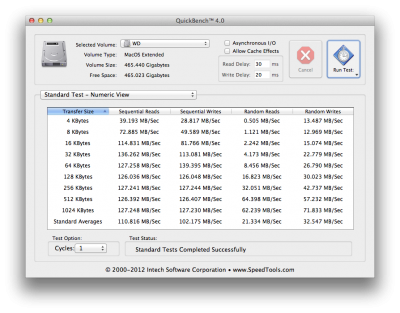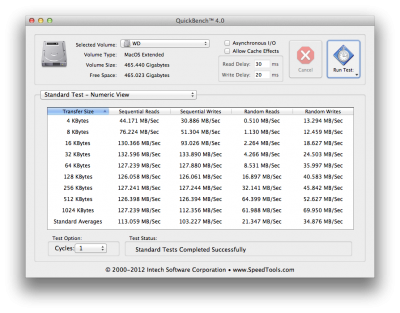Yes, I'm aware of that, I used to use IDE RAID controllers back in the days...
\]
thelostswede
You made me chuckle when I read the line above. ...
I wonder if any one remembers some of the other lost Drive technologies ....
like SCSI which was an Apple standard a many years back.
This includes the versions of SCSi like - Wide SCSI, Narrow SCSI, Fast and Wide SCSI, SCSi 2 and 3.
Or ESDI the red headed step child / grandfather of IDE ... and yes even before IDE we had an earlier version of IDE w control and data cables separate along w power like MFM.
Or the original MFM drive writing technologies when Hard Drives were only 5 MB and were 8 inch form factor. aka "early Western Digital - Winchester drives"
Anyone remember in a Galaxy far far away.... the IBM 14 inch Removable Multilevel Disk Packs....came in 75 or 288 MB - and the drive was the size of a washing machine whoopee....
But back to the question - SSD will out perform any Mechanical Hard drive weather its on SATA 2 or SATA 3 - due to the data bandwidth inside the box itself
choke points are the issues that any hardware or electrical designer has to deal with as the data moves a different speeds from place of origin to where it needed --- the only time that Mechanical HD ever getting close would to SSD speed be w custom SAS or Fiber Channel hard drive's and controllers w 15K hard drives like the main frame and mini mainframe / servers such as HP / IBM use over a 10 GB Ethernet or 16GB Fiber channel links using raid 10 /50. But we wont see that in anyone's hackintosh soon...... wink wink!
If you have drives in RAID 0 on what every interface you want the data is written to both drives and when needed it is read from both drives - so this is the best example of improving the data channel bandwith - the theory is that from a single drive to two drives in RAID 0 you are able to read the data from the disk to the CPU at a 40 % improvement vs the single drive - now if this is done w TWO SSD's then shazam its as fast as greased lightning.... and your too rich! Now this improvement is not universal for all data - your packet size is also important the sector size - 4k 8k 16k etc. This also has an effect on how fast the data is moved from HD to CPU.
But what we are also missing in this Discussion is that Hybrid Drives which have both SSD and fast mechanical drive assemblies can be used in RAID to get to ALMOST the levels of an single SSD only drive and would most likely be a good alternative to SSD only for RAID - but as the Cache Ram which is the SSD side of a Hybrid is rather small IMHO and will be increased to improve performance once acceptance is established is what is needed - so if you are looking at Hybrid Drives get the biggest or largest amount of ram (cache) that you can for this technology. Where I see this as a player is in laptops that have the need for speed and capacity - as having two of these Hybrid drives in Raid 0 would be assume if your laptop has two drive bays.
What is going to be interesting is when we really get what we all want is LARGE CAPACITY SSD- say 1-2 TB or more. As the current design specs for either memory types used in today's SSD's will have issues w performance due to the large array of ram that the drive contains. The snappy speed we see today in the current SSD's will be more like the fastest SATA mechanical Hard Drive's of today.
And yes I do think that SATA will also go the way of the DODO bird and we will be using something else to increase data transfer cause its all about getting to the data in today's information ( its all about me) hungry world.
Its all about the bandwidth Baby...
Yes I am older than dirt..... Peace Out..


